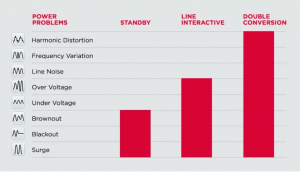
Uninterruptible power supply or source is an electrical apparatus that provides emergency power to a load when the input power source or mains power fails. A UPS differs from an auxiliary or emergency power system or standby generator in that it will provide near-instantaneous protection from input power interruptions, by supplying energy stored in batteries, super-capacitors, or flywheels.
The on-battery run-time of most uninterruptible power sources is relatively short (only a few minutes) but sufficient to start a standby power source or properly shut down the protected equipment. It is a type of continual power system.
Passive-standby systems
These systems provide the lowest level of protection and are the least expensive of the three. These off-line systems monitor incoming power and switch to a battery source when an interruption occurs. This transfer takes place in milliseconds and is acceptable for some computer-based applications. But the loss of power during the transfer can disrupt the operation of some types of sensitive electronic equipment. These UPS also do not filter power-line noise or voltage spikes or sags. Because of these limitations, their use is limited largely to desktops or similar systems not performing critical tasks.
Line-interactive systems
These systems insert a transformer or an inductor between the power source and the connected equipment, and a bank of batteries helps condition and filter incoming power. The systems offer more protection than their passive-standby counterparts but do not completely isolate the protected equipment from irregularities in the incoming power. The systems offer adequate protection for many facility applications but not enough protection for mission-critical operations, such as data centers.
Double-conversion systems
These systems are true online UPS. They eliminate the momentary loss of power found in the other two types of UPS in the transfer from incoming power to battery-supplied power by using a bank of batteries connected to the direct-current part of the system.
These UPS fully isolate protected equipment from the power source, thereby eliminating most power disturbances. They provide run times that range from 15 minutes to as long as the generator’s fuel lasts, depending on the battery bank’s size and whether the system includes a standby generator.
Uninterruptible power supply or source is an electrical apparatus that provides emergency power to a load when the input power source or mains power fails. A UPS differs from an auxiliary or emergency power system or standby generator in that it will provide near-instantaneous protection from input power interruptions, by supplying energy stored in batteries, super-capacitors, or flywheels.
The on-battery run-time of most uninterruptible power sources is relatively short (only a few minutes) but sufficient to start a standby power source or properly shut down the protected equipment. It is a type of continual power system.

What type of UPS Do I Need?
Make a list of your most common power problems from the definitions above, and use the chart below to pick which topology solves your problems.

